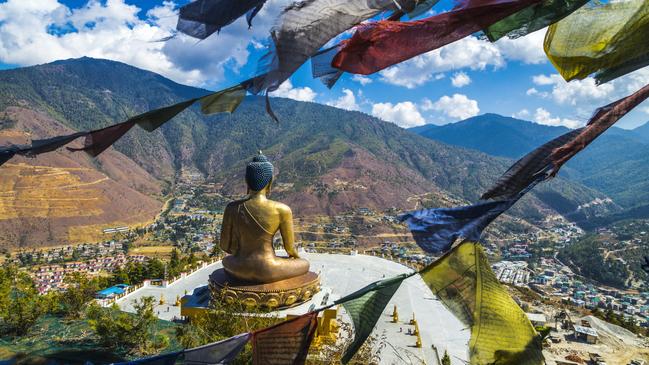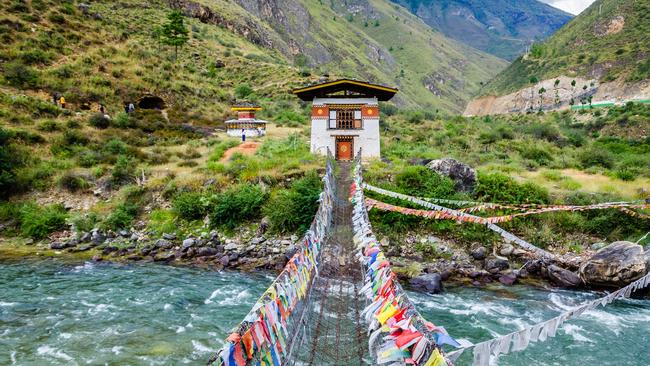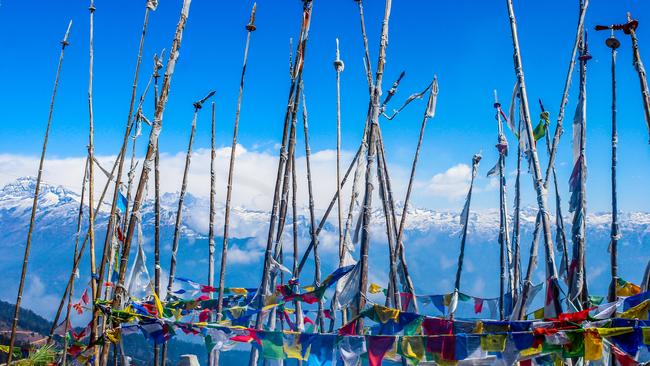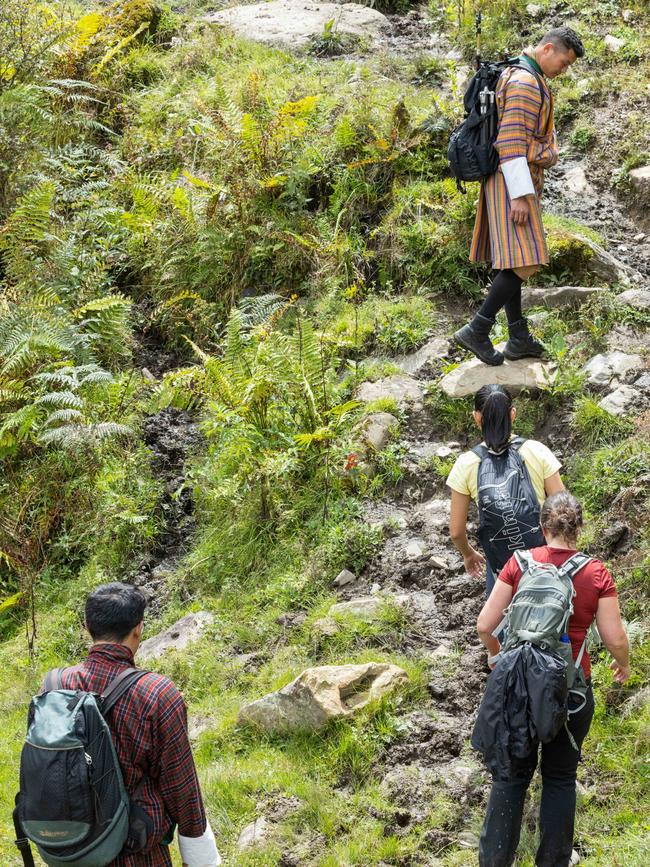Bhutan is back (but can you afford it?)
The enigmatic Himalayan kingdom’s borders have reopened — with a catch. Tourists will be taxed $310 per day to offset carbon emissions and plant trees.

With its gentle Buddhist values, elegant national costume worn every day and devotion to its monarch, Bhutan has long maintained the mystique of a forbidden Himalayan kingdom, little influenced by the outside world and difficult to access. That access was cut altogether during the pandemic, when borders shut tight for 2½ years. The country finally reopened late last month to rhapsodic scenes at Paro airport, as four flights landed in succession and a who’s who of Bhutanese politics and business were in attendance as traditional dancers welcomed the first crop of tourists.
In the crowd I meet Tandi Wangchuk, chief executive of Drukair, the national airline, who’s already hustling to increase flight capacity. “I want a new route to Dubai before the end of the year, to allow our European friends to visit us more easily.”
The freshly hatched visitors fan out from the airport, mostly eastwards to explore the three valleys of Paro, Thimphu or Punakha. But I am heading west to the town of Haa, passing Paro’s pretty earthen houses, elaborately decorated with brightly painted window frames and cornices. The road swings left and right, up a winding series of hairpins, towards the border with India.

My destination, with its timber houses, fortified temples and prayer halls, lies at the western point of the Trans Bhutan Trail, a freshly launched route of just over 400km that spans the width of the country, taking trekkers through forest glades, along the banks of gushing streams, over mountain passes and through national parks. For anyone with the time and resources, the full hike takes several weeks. I am cherry-picking a few sections, which is the more practical, even canny, approach to experiencing the trail.
I have chosen the Haa to Paro section, just under 65km long, winding through wilderness and offering fine views of the snow-capped Himalaya. I also do a day trek from the capital, Thimphu, up to the Dochula Pass, which is less of a success because at times the trail joins the road, passing factories and makeshift camps.
I might be one of the first visitors to set foot on this newly named trail, but it has been in existence for millennia, part of a network of paths used by monks and messengers, transhumant herders, emissaries and traders. It fell into disuse as road construction began in the 1960s. The hope is that by restoring the footpaths, so tourists can theoretically walk the entire length, this historic route will be resuscitated. Along the trail are white blazes painted on trees and more than 170 intermittent wooden posts, each with a QR code, offering those willing to pay for data roaming the chance to learn more about nearby cultural sights and local myths and legends. Some have infographics while others feature animations to bring the stories to life. For an ancient trail it’s all very 21st-century. In spite of the navigational assistance, however, it is still mandatory to hire a guide booked through an approved tourism service. I choose the not-for-profit outfit Trans Bhutan Trail, which was behind the initiative of restoring the route and operates itineraries here. It ploughs all its revenue back into the trail and surrounding communities.

From Haa, I arrive at the trailhead to discover a steep start, up through spruce and larch and Himalayan blue pine. Early morning drizzle has left the ground wet and mulchy underfoot; mushrooms and toadstools sprout, some with concave caps filled with rainwater. There are wild primula and marigolds and, at higher altitudes, lichens draped over the branches of hemlock trees. Rhododendron grow only to the size of an azalea here. But, above all, what I love most is that it feels like my guide and I have the mountain to ourselves, a lonesome pair moving up the pine cone-strewn trail.
Although we don’t cover a great distance, perhaps 6.5km that first day, the vertical shifts are radical. With the steepness of the trails, it feels more like moving up the rungs of a ladder than the flanks of a hill. I choose to camp to have the full in-nature experience, as well as to support locals who have seen no work for more than two years. Travellers can also stay in guesthouses or hotels as bases for day hikes.
The camp crew has gone ahead, setting up just below the Chelela Pass, at about 4000m, pitching the tents on a grassy knoll. It is exposed and windy, but my hope is to wake to see the snowy peaks of Jomolhari or Jichu Drake, rising up about 6700m above sea level. I turn in, listening to the tinging of tent zips and beating of nylon, reminding me of the flapping prayer flags I heard during the day. The Buddhists believe prayers written upon those colourful flags are carried up to mountain deities.

There’s heavy rain overnight and in the swirling cloud of dawn I see nothing more than the tips of my fingers on my outstretched arm. Yet there’s something about camping in inclement weather that I relish, as a pilgrim might. A Buddhist nun in Bhutan once told me that the greater the hardship, the more merits I would earn, the more wisdom I would accumulate. So I feel the squelch of my socks with some satisfaction.
It’s no coincidence the trail has launched as the country is reopening. The government is renewing efforts to forge ahead with Bhutan’s renowned high-value, low-volume tourism model. It wants to appeal to “environmentally aware, socially responsible tourists”, as Lotay Tshering, the Prime Minister, puts it to me. In line with that, his government has raised the daily tax on tourists, the sustainable development fee (SDF), to $US200 ($310) a person. Income will be used to maintain the trail, plant trees to offset the carbon footprints of visitors, up-skill workers in the tourism sector and electrify Bhutan’s transportation network.
The revised tariff is not a perfect solution. There are travellers who will be able to afford the higher daily levy but are not interested in the values Tshering espouses. Equally, the fee will cut out some potential visitors who are of the exact profile that matters most to him.


When I petition him to discuss this more, we end up on a trek together. It turns out that’s how you can interview the prime minister of this Himalayan kingdom – with hiking boots on.
He is well aware of the concerns of workers in the tourism sector, some of whom believe overseas visitor numbers will plummet from the 70,000 who arrived in 2019. But Tshering unwaveringly believes in long-term thinking, which, he says, doesn’t preclude that arrivals could grow, even double, as long as the tourism is sustainable. “I have to make a call,” he tells me. “And the pandemic taught us a lesson not to rely on tourism as a main revenue earner. Let’s also think of it as a way to create a modern and literate society, to create gainful employment, to share our culture.”
There are some taking up that charge. An old friend of mine, Dorji Dema, has for now mothballed her homestay business in Paro and opened a shop selling bows and arrows. Archery is the revered national sport and when I find Dorji and her husband, a birding guide, they are proudly organising the shop displays. “We were worried tourists wouldn’t return,” she says ruefully. “But we’ll open the homestay again if they come back.” Penden Wangchuk, a hotel employee, admires the new policy. “Look at Nepal. Their country is completely spoilt by mass tourism. It will be hard in the short term for us, but my younger siblings are going to have a better future.”

For all that optimism, there are also frontline operators here who worry that smaller independent businesses, such as three-star guesthouses, camping outfitters and freelance guides, will lose their livelihoods. My own guide, Lhakpa Druk, 30, tells me he’s anxious thinking about the next few months. “I thought my career was always going to be as a guide,” he says. “But now I’m looking at farming rice or vegetables or leaving the country.”
As I follow the mountain track alongside the PM, high above the burgeoning capital of Thimphu, the city is strangely silent, although we can see below us the jammed traffic on the roads and busy construction sites, like watching a film with the volume off. The sun emerges from behind a cloud and amid the urban sprawl there are glints from the gold-leafed rooftops of temples and monasteries. Looking at this city, temporarily muted, I feel that there surely must be room in the world to try quieter pioneering tourism strategies like this one. “I’m here to think beyond the next few years,” Tshering says, interrupting my thoughts. “I need to take care of Bhutan’s unborn children who are not even with us yet.”
Michelle Jana Chan was a guest of Trans Bhutan Trail.
THE TIMES

To join the conversation, please log in. Don't have an account? Register
Join the conversation, you are commenting as Logout